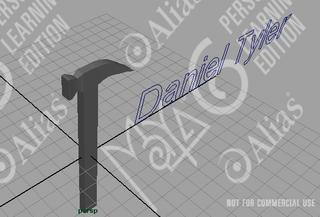Learning to create images in Maya

Over the past two classes we have learned some of the ins and outs of the Maya Personal Learning Edition program. Specifically we have roughly followed a few of the tutorials to create common items that can be found anywhere. However, even though the items are simple, creating them was not. Our first challenge was to create a hammer. This sounds easy enough as there are not any odd shapes or outrageous curves in a hammer that might give a novice such as myself difficulty. Apparently I spoke too soon. It took us a good portion of our class to work on the rough outline of the hammer, as seen to the right. We learned to extrude faces, alter vertices and maneuver the object for the best vantage point. The hardest part of creating this image was the back end, the curve of the hammer. Curving a straight piece is no easy task and required a few attempts before it somewhat resembled a hammer piece. I have found the most frustrating thing so far is my inability to edit the object at a point earlier in its construction. By this I mean that if I wish to go back a few steps to correct a minor mistake it is extremely hard to alter what is necessary. Instead I have found myself undoing all the steps leading back to the mistake in question. Then the mistake is corrected and all of the steps that were undone must now be performed again. In creating an object it appears that the author must know exactly what the object will look like before even starting, as this will limit the amount of step repeats that I encountered when creating the hammer object.
Along with creating a hammer we also worked on creating symmetrical objects, such as a cup. To the left is the cup that was created in class this past Sunday. This cup was created in a different method than that of the hammer. While the hammer was created one block at a time, the cup was created one point at a time.
 By this I mean that we created a set of points on the grid that corresponded to what half of the cup would look like as a cross-section. These points were automatically connected together by the Maya program and when we revolved the cross-section they created the solid object you see to the left. This image could then be fine-tuned to resemble a cup as much as possible by moving the individual points in order to round out the edges and give the object more realism. This feature of revolving a set of points is extremely helpful in creating symmetrical objects, but is very limited in when it can be used. Objects such as cups, bowls, plates, candlesticks and the like are the only such objects that can be created in this manner. Anything with an irregular shape, such as a clock or piece of furniture would have to be created in the same manner as the hammer.
By this I mean that we created a set of points on the grid that corresponded to what half of the cup would look like as a cross-section. These points were automatically connected together by the Maya program and when we revolved the cross-section they created the solid object you see to the left. This image could then be fine-tuned to resemble a cup as much as possible by moving the individual points in order to round out the edges and give the object more realism. This feature of revolving a set of points is extremely helpful in creating symmetrical objects, but is very limited in when it can be used. Objects such as cups, bowls, plates, candlesticks and the like are the only such objects that can be created in this manner. Anything with an irregular shape, such as a clock or piece of furniture would have to be created in the same manner as the hammer.

0 Comments:
Post a Comment
<< Home